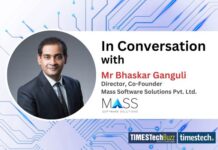Electronica happened from November 15-18 in Germany. Texas Instruments (TI) booth in electronica showcased a range of products related to Renewable Energy, Electric Vehicle charging, power conversion etc. TimesTech in an exclusive interview with Harald Parzhuber, Systems Manager – Grid Infrastructure, Texas Instruments tried to learn more about what all happened at TI’s booth at Electronica.
Read the edited excerpts:
TimesTech: What Texas Instruments Showcased at electronica?
Harald: At the Electronica, the theme was Renewable Energy and we had a couple of demos there. One was about demonstrating the connectivity and the computing capabilities we have with the products at Texas Instruments. That was a demo that showcase the product called AM6254, with capabilities it has, from a communication perspective. We demonstrated the communication from an EV charger into a car.
The other aspect is to demonstrate the Open Charge Point protocol-specific layers that are defined in the Open Charge Point protocol. Here we demonstrated how we can achieve this and run this on the AM2654 platform that we have been developing. It demonstrated front-end communication and back-end communication.
One demo was more focused on power conversion systems. Within power conversion systems a very important building block is the AC/DC converter stage. So, what we demonstrated there was the very first building block whether the grid is connected to an AC/DC converter.
We had a live demo, connecting AC to a DC and DC back to AC to demonstrate 11 kilowatt circulating power. We used two converters which were used in opposite method testing. Opposite method testing means one is running as a rectifier, taking the AC and generating a DC.
We had two designs, SiC-based and GaN-based. They were operating live at 11 kilowatt and we could circulate the power.
TimesTech: How does bi-directional charging could be a game-changer and what innovations and development Texas Instruments has made in this concept to make it more efficient and safer?
Harald: The EV charger is used for vehicle-to-home or vehicle-to-grid communication. The AC/DC stage needs to operate in both directions to enable vehicle to home and vehicle to grid. Also, enable energy storage from the grid into Battery Systems and taking that excess energy back into the grid when there is a demand in the grid. There are a couple of possibilities that can support that. There are two typologies like a T-type and an Active Neutral Point Clamp. Those are topologies, which can be operated with digital control in both directions by a microcontroller. It enables power flow from the grid to the DC sources and back from the Vehicle-to the grid. This helps to make the grid more resilient.
We see already today vehicle to home use case. It helps your residential installation to cope with higher existing power demand while you have a car parking in your garage. That is happening already and we see offerings for DC wall boxes. The boxes can take the battery energy back and T-type or ANPC topologies are perfectly suited for that.
We demonstrated that at the same efficiency a converter in Silicon Carbide needs to run it slightly lower switching frequency, which is driving the size of the passive components, a little bigger. So, you can make a Gallium Arsenide-based solution, probably between 10 and 15 percent smaller. You can operate it, with possibly 40% higher switching frequencies to achieve still the same efficiency. We were operating both converters at 98.2% efficiency.
TimesTech: Are the innovative products that you showcased in electronica available in the market?
Harald: All are the released products have been showcased at electronica. So, for example, we used a GaN switch with 30 mOhm on resistance. TI GaN FET is not just a GaN FET, it has more functions in it. It has a temperature sensor integrated. It has the gate driver integrated with all the bias supply needed for the negative biasing of the Gallium Arsenide FET. That is all integrated into the TI-GaN device. All that is available on ti.com right now. So, nothing was outlook, we demonstrated existing technology at electronica.
For the current sensing, we showed shunt-based current sensing. We have the AMC1xxx product family released since a couple of years with a very low input voltage range.
We demonstrated shunt-based current sensing to eliminate the rumors about being power-hungry and having a voltage ripple impact at the current measurement points.
TimesTech: How has the market responded to TI’s products?
Harald: TI is known as the company that is doing all the signal processing, is doing all the signal train products, and has a lot of power products. But when it comes to the high-power switches, people assumed TI is not playing at much in the market. With the GaN portfolio, we have at TI, there was very good resonance. People liked very much the level of integration that we demonstrated. The GaN device have a lot of protection features integrated which simplifies design significantly.
TimesTech: What advancement TI has made in the efficient grid and renewable energy system?
Harald: We had been showcasing that we are not concentrating only on the sub-functions like the point of load or low-power offline supplies. We have been demonstrating that with digital power control, we can build highly efficient systems. It can be used for the renewable energy market, where efficiency, reliability, and safe operation are needed. As an example, the Sitara MCU family has integrated safety islands. That means you can build systems that have functional safety integrated. Historically, in solar inverters or renewable energy safety was less of a concern. Now, we see more and more people taking care of certified products.
TimesTech: What is the future technological integration that we can see from Texas Instruments in the area of Electric Mobility and assist driving?
Harald: Giving more compute power to the digital controllers, integrating more functionality into one MCU, where it makes sense as an example historically, if you build a DC-DC or AC-DC, you can operate this in two separate MCU. With the Sitara MCU, which is a multi-core MCU family, we can run distribute AC/DC, and DC/DC boost to multiple MCUs. We have another MCU running an ARC detection algorithm. We are moving to build more functionalities into the controllers, and maintain high quality on the Analog functions like PWM generation and high precision AD-converters with high accuracy on the voltage and current feedback passes, which is crucial in digital power conversion systems.















